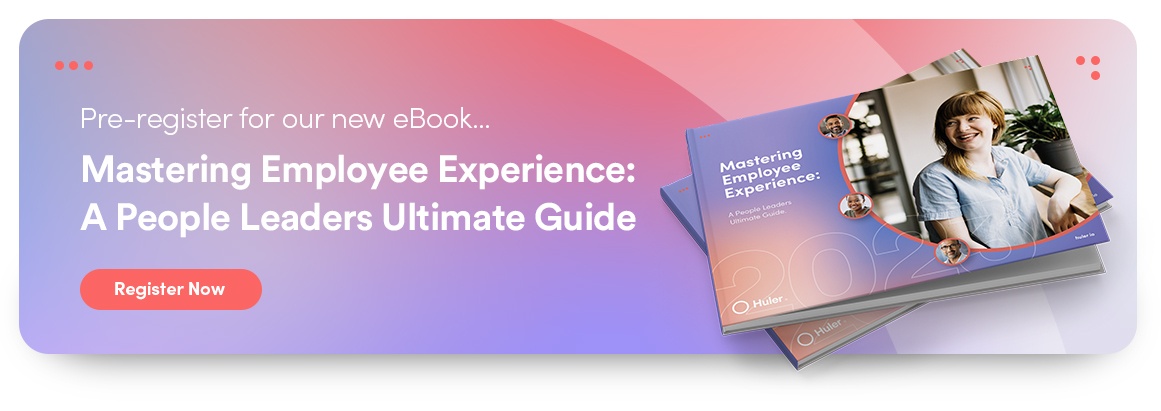Employee engagement is a big challenge for people leaders right now, and when it comes to supporting and engaging your employees, there isn’t a one-size-fits-all approach.
In order to identify new opportunities to improve the employee experience and boost engagement, it’s important people teams stay up-to-date with the latest trends.
To help, we’ve summarised the top 6 trends many HR teams will begin to adopt in the workplace over the next year.
Experience-led digital transformation
If your employees don’t feel part of a team, it can lead to high rates of disengagement. Hybrid/remote models are making it more difficult for HR teams to create that sense of belonging that boosts engagement. As a result, many organisations are turning to tech to improve the overall employee experience.
Whilst there are many benefits to digital transformation, if done incorrectly, there’s a strong chance it will hinder, not help.
Look out for:
- Change fatigue – when tech has been poorly implemented in the past, employees are likely to disengage from any solutions you adopt in the future. By involving your end-users in the decision-making process and continually gathering feedback once implemented, you’ll achieve maximum ROI.
- Tech sprawl – combine a vast tech market with competing team requirements and its easy to fall victim to an overwhelming tech stack. This can be expensive, and counterproductive. First, consider consolidating all of your workplace tech into one place. This will help reduce frustration and give you an understanding of how your current tech is being used.
A focus on wellbeing
It’s reported that 81% of job seekers are looking for companies where mental health is actively supported. With the rising challenge of talent acquisition and retention, you can expect to see a spike in HR teams prioritising their wellbeing initiatives.
This might look like:
- Investment in wellbeing platforms: Every employee is unique, so offering an ‘always on’ resource like an Employee Assistance Program (EAP) ensures your people have access to the support they need, when they need it.
- Managerial training: With more employees working remotely, it can be difficult for managers to spot signs that an employee is struggling. HR teams will begin to make training a priority – ensuring managers are equipped to not only recognise the signs but also how to support them.
- Recognition and reward: Praising employees on a job well done has always been a great way to keep teams engaged. This is harder in a remote setting, which is why HR teams are looking at new ways to encourage day-to-day managerial and peer-to-peer recognition.
Greater DEI investment
A strong DEI strategy ensures a diverse voice, enhances organisational culture and bridges skills and knowledge gaps. As a result, people leaders are now starting to look at optimising the end-to-end employee journey to ensure inclusivity at every touch point, including:
- Unconscious bias: Raising awareness and analysing each of the employee touchpoints will keep unconscious bias in-check throughout the employee journey.
- Personalised opportunities: Personalising communications and opportunities will ensures employees feel included.
- Response frameworks: Clear, well-defined response frameworks with DEI at the forefront will ensure crisis comms live up to company values.
Refreshed hybrid workspaces
Bridging the gap between remote and in-office workers will become a priority. This might include new tech solutions, such as an employee experience layer, innovative team-building activities, or a review of the office layout.
Whatever the method, organisations are taking another look at how they can unite their people and create the best experiences, wherever they are.
Take our free employee experience quiz for an insight into how well your workplace is equipped for changing working patterns.
AI (yep, you guessed it)
It’ll come as no surprise that there will be a seismic shift in HR teams adopting AI solutions over the next year or so. In fact, its predicted 80% of global companies will begin to transition to algorithmic recruitment methodologies by 2024.
Whilst it’s definitely a hot topic right now, there are some things HR teams need to consider:
- Empower, don’t replace: AI is at its most useful when it powers up workflows that are already in place (such as data conversion and transcription).
- Match AI to your HR goals: Before you rush into adopting the latest AI-backed tool on the market, assess whether it’s really going to drive forward your biggest HR priorities – especially when it comes to learning and development.
Upskilling replaces acquisition
Rising attrition rates, fears around economic downturn, energy costs, and inflationary pressures, are all contributing factors to tighter spending and recruitment freezes. As a result, we can expect to see a shift in focus, where upskilling and retraining existing employees and promotion from within will be prioritised.
Before you invest in an expensive L&D program though, audit your existing resources and ensure they’re up-to-date and easily accessible. For example, create resource libraries and ensure they’re stored on a user-friendly platform.
HR trends are ever-changing, so anticipating the next HR what the future of work will look like should never get in the away of supporting your employees.
Being empathetic and connected to your employees has never been more important, which is why we believe employee experience should continue to stay at the forefront of any HR strategy. 




